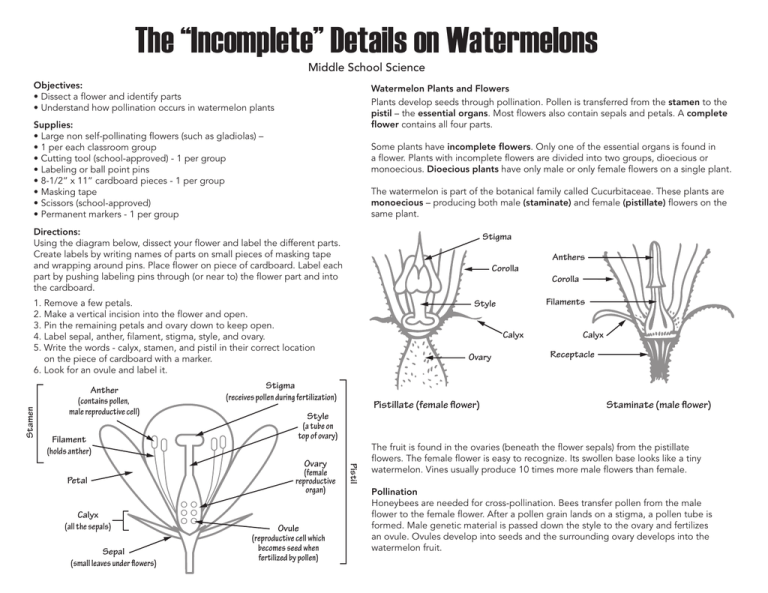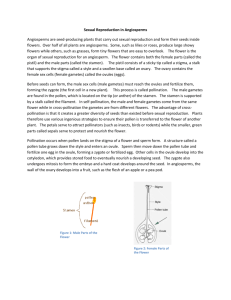The “Incomplete” Details on Watermelons Middle School Science
advertisement

The “Incomplete” Details on Watermelons Middle School Science Objectives: • Dissect a flower and identify parts • Understand how pollination occurs in watermelon plants Watermelon Plants and Flowers Plants develop seeds through pollination. Pollen is transferred from the stamen to the pistil – the essential organs. Most flowers also contain sepals and petals. A complete flower contains all four parts. Supplies: • Large non self-pollinating flowers (such as gladiolas) – • 1 per each classroom group • Cutting tool (school-approved) - 1 per group • Labeling or ball point pins • 8-1/2” x 11” cardboard pieces - 1 per group • Masking tape • Scissors (school-approved) • Permanent markers - 1 per group Some plants have incomplete flowers. Only one of the essential organs is found in a flower. Plants with incomplete flowers are divided into two groups, dioecious or monoecious. Dioecious plants have only male or only female flowers on a single plant. The watermelon is part of the botanical family called Cucurbitaceae. These plants are monoecious – producing both male (staminate) and female (pistillate) flowers on the same plant. Directions: Using the diagram below, dissect your flower and label the different parts. Create labels by writing names of parts on small pieces of masking tape and wrapping around pins. Place flower on piece of cardboard. Label each part by pushing labeling pins through (or near to) the flower part and into the cardboard. Stigma Corolla Stamen 1. Remove a few petals. 2. Make a vertical incision into the flower and open. 3. Pin the remaining petals and ovary down to keep open. 4. Label sepal, anther, filament, stigma, style, and ovary. 5. Write the words - calyx, stamen, and pistil in their correct location on the piece of cardboard with a marker. 6. Look for an ovule and label it. Anther (contains pollen, male reproductive cell) Filament (holds anther) Calyx (all the sepals) Sepal (small leaves under flowers) Pistillate (female flower) Style (a tube on top of ovary) Ovary (female reproductive organ) Ovule (reproductive cell which becomes seed when fertilized by pollen) Pistil Petal Calyx Stigma (receives pollen during fertilization) Corolla Filaments Style Ovary Anthers Calyx Receptacle Staminate (male flower) The fruit is found in the ovaries (beneath the flower sepals) from the pistillate flowers. The female flower is easy to recognize. Its swollen base looks like a tiny watermelon. Vines usually produce 10 times more male flowers than female. Pollination Honeybees are needed for cross-pollination. Bees transfer pollen from the male flower to the female flower. After a pollen grain lands on a stigma, a pollen tube is formed. Male genetic material is passed down the style to the ovary and fertilizes an ovule. Ovules develop into seeds and the surrounding ovary develops into the watermelon fruit.





